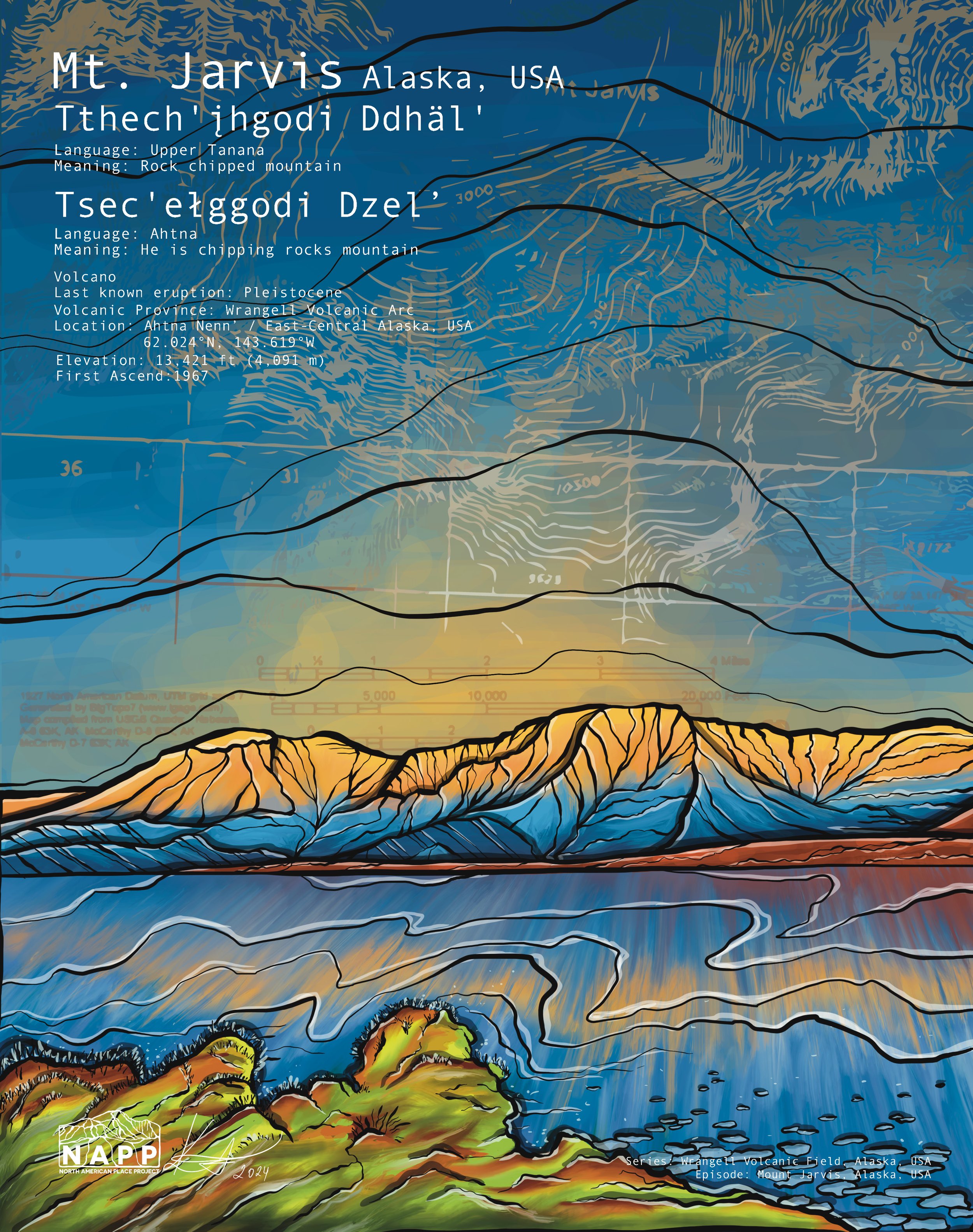Mt. Sanford Poster - 11x14inch
FREE SHIPPING IN THE UNITED STATES
Poster material: Glossy Cardstock
Size: 11 × 14 inches
*all materials are printed locally in Alaska to help support small local businesses
Mt. Sanford / Hwniindi K'ełt'aeni
Language: Ahtna
Meaning: Upstream from The One (K'ełt'aeni)
Volcanic Province: Wrangell Volcanic Arc
Location: Ahtna Nenn’ / East-Central Alaska, USA
Type: Shield Volcano
Age: Estimated to 900,000 years
Last Known Eruption: Estimated to about 320,000 ago
Mount Sanford stands out as a massive, dissected shield volcano, its peak capped by a broad, glacier-clad dome. Notably, it ranks among the highest Quaternary volcanoes in the United States. (Least understood from Drum/Wrangell/Sanford) Towering over the Copper River, its flanks display prominent cirques, carved by grinding of rocks by glaciers, particularly evident on the southwest and southeast sides. The south face is so dramatic and considered the steepest gradient in North America, rising 8,000 feet in one mile. Despite its icy mantle, scientific evidence suggests the upper portion may be younger, potentially Holocene (11,700 years ago - present) in origin, and built upon a foundation of even older coalescing andesitic shield volcanoes. These ancestral structures, located south, northwest, and north-northwest of the summit, initiated their formation roughly 900,000 years ago. Geological records reveal a significant mid-Pleistocene rhyolitic lava (viscous, slow) flow about 600,000 to 500,00 years ago originating from a vent on the volcano's northeast flank, extending over 18 kilometers to the northeast. This single lava flow is locally more than 1,000 ft thick. The most recent radiometrically dated activity dates back to around 320,000 years ago, marked by basaltic lava flows erupted from a rift zone on the northeast flank.
Mt. Sanford is mostly covered by perennial icefields above 8,000 ft in elevation. The icefiled is a source of several alpine glaciers, one of which is Sanford Glacier that originates in the great cirque at the base of the south face. This glacier carries a tremendous amount of debris from constant rockfall and erosion of the steep south face.
FREE SHIPPING IN THE UNITED STATES
Poster material: Glossy Cardstock
Size: 11 × 14 inches
*all materials are printed locally in Alaska to help support small local businesses
Mt. Sanford / Hwniindi K'ełt'aeni
Language: Ahtna
Meaning: Upstream from The One (K'ełt'aeni)
Volcanic Province: Wrangell Volcanic Arc
Location: Ahtna Nenn’ / East-Central Alaska, USA
Type: Shield Volcano
Age: Estimated to 900,000 years
Last Known Eruption: Estimated to about 320,000 ago
Mount Sanford stands out as a massive, dissected shield volcano, its peak capped by a broad, glacier-clad dome. Notably, it ranks among the highest Quaternary volcanoes in the United States. (Least understood from Drum/Wrangell/Sanford) Towering over the Copper River, its flanks display prominent cirques, carved by grinding of rocks by glaciers, particularly evident on the southwest and southeast sides. The south face is so dramatic and considered the steepest gradient in North America, rising 8,000 feet in one mile. Despite its icy mantle, scientific evidence suggests the upper portion may be younger, potentially Holocene (11,700 years ago - present) in origin, and built upon a foundation of even older coalescing andesitic shield volcanoes. These ancestral structures, located south, northwest, and north-northwest of the summit, initiated their formation roughly 900,000 years ago. Geological records reveal a significant mid-Pleistocene rhyolitic lava (viscous, slow) flow about 600,000 to 500,00 years ago originating from a vent on the volcano's northeast flank, extending over 18 kilometers to the northeast. This single lava flow is locally more than 1,000 ft thick. The most recent radiometrically dated activity dates back to around 320,000 years ago, marked by basaltic lava flows erupted from a rift zone on the northeast flank.
Mt. Sanford is mostly covered by perennial icefields above 8,000 ft in elevation. The icefiled is a source of several alpine glaciers, one of which is Sanford Glacier that originates in the great cirque at the base of the south face. This glacier carries a tremendous amount of debris from constant rockfall and erosion of the steep south face.
FREE SHIPPING IN THE UNITED STATES
Poster material: Glossy Cardstock
Size: 11 × 14 inches
*all materials are printed locally in Alaska to help support small local businesses
Mt. Sanford / Hwniindi K'ełt'aeni
Language: Ahtna
Meaning: Upstream from The One (K'ełt'aeni)
Volcanic Province: Wrangell Volcanic Arc
Location: Ahtna Nenn’ / East-Central Alaska, USA
Type: Shield Volcano
Age: Estimated to 900,000 years
Last Known Eruption: Estimated to about 320,000 ago
Mount Sanford stands out as a massive, dissected shield volcano, its peak capped by a broad, glacier-clad dome. Notably, it ranks among the highest Quaternary volcanoes in the United States. (Least understood from Drum/Wrangell/Sanford) Towering over the Copper River, its flanks display prominent cirques, carved by grinding of rocks by glaciers, particularly evident on the southwest and southeast sides. The south face is so dramatic and considered the steepest gradient in North America, rising 8,000 feet in one mile. Despite its icy mantle, scientific evidence suggests the upper portion may be younger, potentially Holocene (11,700 years ago - present) in origin, and built upon a foundation of even older coalescing andesitic shield volcanoes. These ancestral structures, located south, northwest, and north-northwest of the summit, initiated their formation roughly 900,000 years ago. Geological records reveal a significant mid-Pleistocene rhyolitic lava (viscous, slow) flow about 600,000 to 500,00 years ago originating from a vent on the volcano's northeast flank, extending over 18 kilometers to the northeast. This single lava flow is locally more than 1,000 ft thick. The most recent radiometrically dated activity dates back to around 320,000 years ago, marked by basaltic lava flows erupted from a rift zone on the northeast flank.
Mt. Sanford is mostly covered by perennial icefields above 8,000 ft in elevation. The icefiled is a source of several alpine glaciers, one of which is Sanford Glacier that originates in the great cirque at the base of the south face. This glacier carries a tremendous amount of debris from constant rockfall and erosion of the steep south face.









